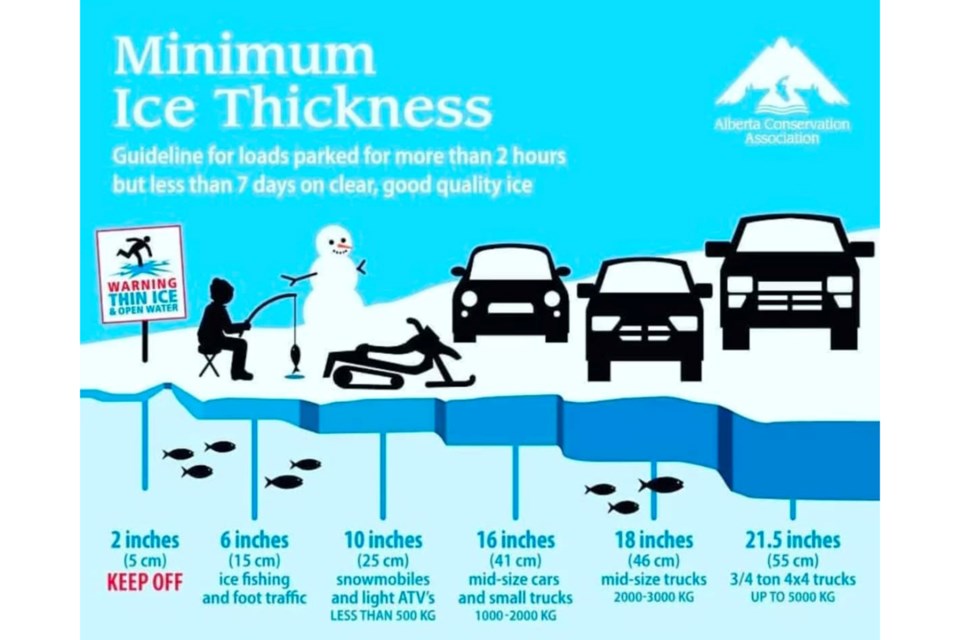INNISFAIL – With the weather expected to be warmer this week Innisfail RCMP is advising citizens to be cautious around frozen reservoirs in the area following a trio of holiday season incidents at Sylvan Lake where vehicles broke through the ice.
At least two of the incidents occurred while people were ice fishing. There were no reports of injuries.
The lake is spring fed with varying thickness of ice during the winter; conditions that can be hazardous for adventurous anglers.
And throughout this week and into next the forecast is for warmer weather in the region with temperatures climbing close to zero celsius; a potential danger for recreation enthusiasts pursuing winter activities.
Innisfail RCMP Staff Sgt. Ian Ihme said he doubted the Sylvan incidents could happen at Innisfail’s Dodd’s Lake, which has become a popular spot in recent years for anglers.
While Dodd’s Lake is an area the Innisfail RCMP patrols for various reasons Ihme noted the local body of water is “fairly shallow” compared to Sylvan Lake.
“At Sylvan there is somewhat of a spring feed into it which causes some areas to be thinner and thicker,” said Ihme, adding since his posting in Innisfail almost three years ago there have been no similar incidents at Dodd’s Lake with citizens going through the ice.
However, he does have concerns about winter conditions at Gleniffer Lake, 23 kilometres west of Innisfail.
“Just because it is a reservoir. The water levels can fluctuate wildly as the lake freezes,” said Ihme. ”As the lake freezes, the water can actually drop below the ice, which obviously does cause quite a bit more concern, just because there is a bit of a danger.
“Since I've been here we haven't had anybody go through but I am personally very cautious on frozen reservoirs just because of that fluctuating water.”
In the meantime, RCMP are offering important tips to citizens to ensure safety when heading out to ice covered ponds or lakes:
• always check the thickness of the ice before venturing onto it. As a general rule, ice should be at least 20 centimetres (cm) or eight inches (in) thick for walking or 25 cm (10 in) for snowmobiles;
• use a tape measure, drill, or auger to make sure the ice is thick enough and check in multiple locations because ice can vary in thickness;
• pay attention to fluctuating temperatures. Even if ice appears thick, warming weather can cause it to weaken. In early winter, ice may not be as strong due to variations in temperature, so caution is crucial;
• stay away from cracks, pressure ridges, or areas with moving water, as these zones can compromise the integrity of the ice;
• if you’re near a river or stream, be extra cautious, as moving water under the ice can erode it more quickly, creating dangerous spots that may not be visible.
• never go out on ice at night and never go alone;
• carry a rope or throw line, and know how to use it in case of an emergency;
• if temperatures have recently fluctuated, or the ice has visible cracks or slush on top, avoid it altogether;
• ice can weaken and crack under the pressure of people, vehicles, or snow, so always stay alert to the conditions around you. Warm weather or heavy snow can create hidden slush pockets that might trap your vehicle, so proceed with caution, and
• after a warming period, refrain from going onto ice in the early morning or late evening, as it may be weaker.
And if people fall through the ice the RCMP is offering this advice:
• leave your vehicle right away. If you’re in the water, move toward the edge of the ice and break through until you reach solid ice that can support your weight;
• act quickly—every moment counts. Lie flat on your stomach and crawl onto the ice, distributing your weight as much as possible. Sharp objects like nails or spikes can help you grip the surface;
• find warmth as soon as possible and remove wet clothing. This might mean heading to shore and starting a fire without delay, and
• keep in mind that hypothermia can set in rapidly, leaving you unable to help yourself. Act fast to stay safe.



